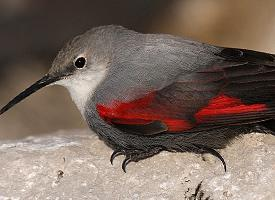
Popis zvířete
The Wallcreeper (Tichodroma muraria) is a small yet striking bird that inhabits the rocky landscapes of Eurasia, from southern Europe to central Asia and China. This bird is particularly known for its distinctive appearance and unique behavior, which make it a fascinating subject of study for ornithologists and birdwatchers alike.In terms of physical description, the Wallcreeper measures approximately 15.5 to 17 cm in length, with a wingspan ranging from 25 to 28 cm. It weighs between 17 to 19 grams, making it a relatively lightweight bird. The most striking feature of the Wallcreeper is its plumage. The bird sports a slate gray body that provides excellent camouflage against the rocky terrains it inhabits. However, it is the bright crimson patches on its wings that truly set it apart. These patches are especially visible during flight or when the bird is displaying. The contrast between the gray body and the vivid red wings creates a spectacular visual effect that is hard to miss. The tail is also adorned with black and white bars, adding to its distinctive appearance.
The Wallcreeper's bill is long, thin, and slightly curved, designed for extracting insects and spiders from crevices in the rocks. Its legs are strong, with large, curved claws that are adept at navigating the vertical rocky surfaces it calls home.
Behaviorally, the Wallcreeper is a solitary creature, often found alone or in pairs. It is a master climber, using its strong legs and claws to scale vertical rock faces with ease. Unlike most birds, the Wallcreeper does not perch but clings to the rock surfaces, moving upwards, downwards, or sideways in search of food. Its flight is fluttering and butterfly-like, adding to its ethereal appearance.
The Wallcreeper's diet primarily consists of insects and other small invertebrates, which it adeptly plucks from crevices in the rocks using its specialized bill. This bird's feeding habits contribute to its ecological importance, as it helps control the populations of certain pests.
Breeding typically occurs from May to July. The Wallcreeper nests in crevices or cavities in sheer rock faces, where it lays 4 to 5 eggs. The nest is constructed by the female and is made of grass and moss, lined with feathers. Both parents participate in feeding the chicks, which fledge approximately one month after hatching.
The Wallcreeper is a migratory bird, with populations in the higher elevations moving to lower altitudes or more southern locations during the winter months. Despite its elusive nature and remote habitat, the Wallcreeper is not currently considered endangered. However, it faces threats from habitat destruction and disturbance from human activities, such as rock climbing and quarrying.
In summary, the Wallcreeper is a mesmerizing bird, notable for its unique climbing abilities, distinctive appearance, and specialized ecological niche. Its presence in the rugged landscapes of Eurasia adds a splash of color and intrigue to the rocky terrains, making it a cherished sight for those lucky enough to observe it in its natural habitat.
Nové fotografie zvířat
Top 10 zvířat
- Chinese water dragon (Physignathus cocincinus)
- Galápagos tortoise (Geochelone nigra complex)
- Dolphin gull (Leucophaeus scoresbii)
- Japanese macaque (Macaca fuscata)
- Colombian red howler (Alouatta seniculus)
- Sea urchins (Echinoidea)
- Diana monkey (Cercopithecus diana)
- Moustached guenon (Cercopithecus cephus)
- Common reed warbler (Acrocephalus scirpaceus)
- Common house mosquito (Culex pipiens)